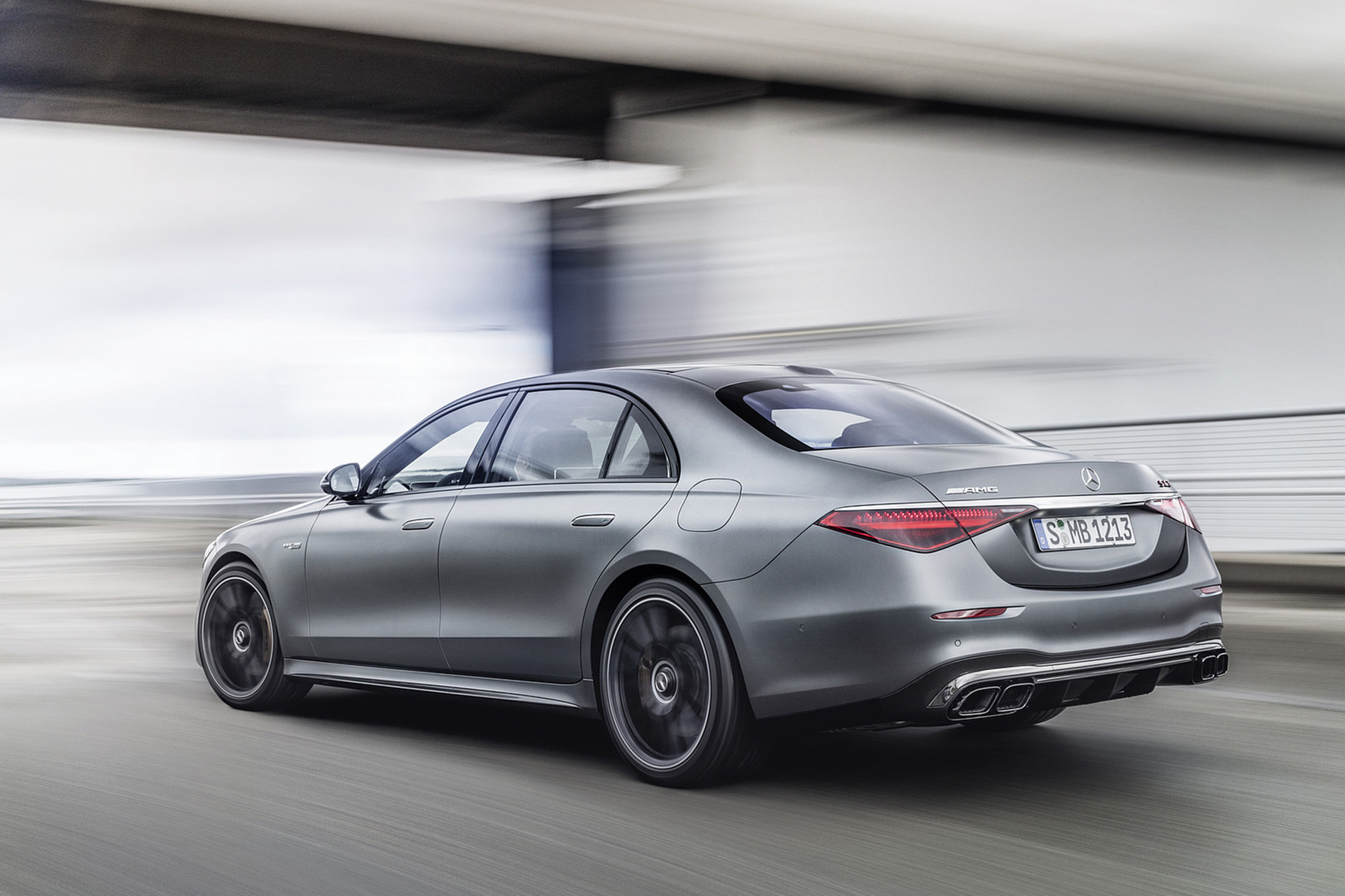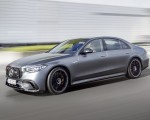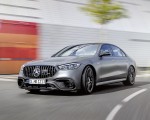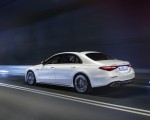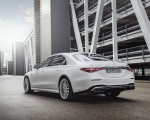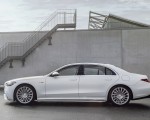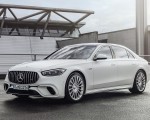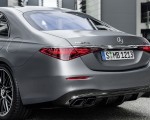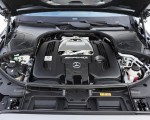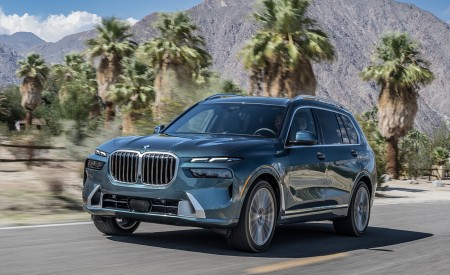2023 Mercedes-AMG S 63 E Performance
- Performance hybrid with technology transfer from Formula 1™ now also in the S-Class segment.
- Larger development stage of the AMG high-performance battery with 13.1 kWh capacity.
- 4.0-litre V8 engine at the front and electric motor at the rear axle for 590 kW (802 hp) system output.
- Active roll stabilisation and active rear-axle steering as standard.
- AMG-specific radiator grille in the performance luxury saloon for the first time.
- Most powerful S-Class of all time.
The S-Class has always played an important role for Mercedes-AMG. More than 50 years ago, the founders already proved that they could transform a luxury saloon into a very sporty vehicle with the Swabian spirit of innovation. The performance and sports car brand from Affalterbach set its first milestone in 1971, with the Mercedes-Benz 300 SEL 6.8 AMG. Today, the new Mercedes-AMG S 63 E PERFORMANCE (combined fuel consumption, weighted: 4.4 l/100 km; combined CO2 emissions, weighted: 100 g/km; combined power consumption, weighted: 21.4 kWh/100 km)with AMG hybrid technology once again sets the benchmark in the segment. The E PERFORMANCE model combines the AMG 4.0-litre V8 biturbo engine with the AMG-specific hybrid powertrain and a new expansion stage of the AMG high-performance battery (HPB). The new HPB 150 is based on the high-performance and directly cooled battery cells of the well-known HPB 80. The energy content increases from 6.1 in the HPB 80 to 13.1 kWh in the HPB 150. This increases the all-electric range to 33 kilometres.
The focus of the powertrain, however, is less on electric range and more on best-in-class performance. With 590 kW (802 hp) of system output and 1430 Nm of system torque, the saloon sets new standards in the segment. The acceleration of 3.3 seconds to 100 km/h and the optional top speed of 290 km/h underline the superior, dynamic driving performance. Systems such as the AMG RIDE CONTROL+ suspension, AMG ACTIVE RIDE CONTROL roll stabilisation and rear-axle steering as standard ensure a wide spread between driving dynamics and comfort.
“The S-Class has always had a very special meaning for us. In 1971, it made the AMG brand famous overnight with its legendary appearance in the Spa 24-hour race. This was undoubtedly an important foundation stone for our rise as a performance and sports car brand with global significance. With E PERFORMANCE, we are now opening a new chapter: Never before has a luxury saloon so perfectly combined best-in-class performance with superior comfort and virtually silent electric driving. In this way, we are also opening up to highly discerning target groups who see Mercedes-AMG as the performance luxury brand of the 21st century. With the most powerful S-Class of all time, however, we are not only going our own technical way, as is characteristic of AMG, but also making a strong visual statement: For the first time, the S-Class Saloon also has our AMG-specific radiator grille, so the brand affiliation is closer than ever before.”Philipp Schiemer, Chairman of the Board of Management of Mercedes-AMG GmbH
“With our unique E PERFORMANCE in the AMG S-Class, we are also setting another technological milestone in electrification in this segment. Our exclusive high-performance battery is used in the S 63 with a significantly higher capacity than previously known, which increases the electric range. The performance hybrid layout with a combustion engine at the front and an electric drive unit at the rear axle not only offers a superior driving experience, but also significantly increases efficiency. The optimised weight distribution, best possible utilisation of torque and the very responsive power delivery promise driving dynamics and driving refinement at the highest level. In addition to the technically sophisticated powertrain, we also pulled out all the stops with the suspension to achieve the greatest possible spread between comfort and driving dynamics. For example, the combination of air suspension, rear-axle steering and active roll stabilisation is on board for the first time in an AMG S-Class.”Jochen Hermann, Technical General Manager of Mercedes-AMG GmbH
Expressive exterior design
The impressive performance of the Mercedes-AMG S 63 E PERFORMANCE is also suggested by the expressive exterior design. For the first time, an S-Class Saloon bears the AMG-specific radiator grille with vertical louvres and a large central star. The previous Mercedes star on the radiator has been replaced by the AMG emblem in silver chrome/black. In addition, the front apron in jet-wing design with large side air inlets and functional air curtains characterises the front view. In the side view, the up to 21-inch AMG forged wheels and the AMG-specific side sill panels particularly stand out. At the rear, there are characteristic design features of the ’63 models such as the trapezoidal, fluted twin tailpipes or the wide diffuser with longitudinal fins and diffuser board.
Elegant interior with First-Class rear compartment
The interior combines the high-quality appointments of the S-Class with AMG-specific features. The seats with a special AMG upholstery layout and distinctive stitching underline the refined appearance. Exclusive colours and various nappa leather upholsteries with an embossed AMG emblem in the front head restraints emphasise either the sporty or the luxurious side of the S 63 E PERFORMANCE. The leadership aspirations in the segment are also made clear by the First-Class rear compartment and multicontour seats for four occupants. Added to this are AMG-specific trim elements and the standard AMG Performance steering wheel with AMG steering wheel buttons.
MBUX multimedia system with hybrid-specific displays
The MBUX infotainment system includes various AMG- and hybrid-specific displays and functions. These include the displays in the instrument cluster, on the multimedia central display in portrait orientation in the centre console and the optional head-up display.
The instrument cluster view can be personalised with different display styles and individually selectable main views. The AMG-specific Supersport style offers the option of displaying various contents via a vertical menu structure. These include a menu with hybrid-specific temperatures or a set-up menu that displays the current settings for the suspension or transmission. In addition, Supersport-style drivers can also have a navigation map, fuel consumption data or all the telemetric data available in AMG TRACK PACE displayed.
The head-up display also offers AMG’s own display styles such as Race and Supersport. These can be accessed via the main menu in the instrument cluster. High-quality graphics in the multimedia display visualise the power flow of the entire drive system, speed, output, torque and temperature of the electric motor, as well as the battery temperature.
The Dolby Atmos® sound format takes the interior audio experience to a new level. Individual instruments or voices in the studio mix can be positioned all around the listening area. A new kind of sound animation thus becomes possible: While conventional stereo systems feed two channels to the speakers, Dolby Atmos® can use the entire range and create a 360-degree experience.
AMG Performance steering wheel in twin-spoke design
The AMG Performance steering wheel with its distinctive twin-spoke design and seamlessly integrated gearshift buttons also contributes to the hallmark AMG look. The AMG steering wheel buttons impress with their brilliant displays and intuitive operating logic. They allow important driving functions and all driving modes to be controlled without the driver’s hands leaving the steering wheel. The recuperation levels of the hybrid drive can also be selected via the steering wheel buttons.
The AMG-specific E PERFORMANCE hybrid drive: combustion engine in the front, electric motor in the rear
In the new Mercedes-AMG S 63 E PERFORMANCE, the 4.0-litre V8 biturbo engine is combined with a permanently excited synchronous electric motor, a high-performance battery developed in Affalterbach and the fully variable AMG Performance 4MATIC+ all-wheel drive system. The system output of 590 kW (802 hp) and the maximum system torque of 1430 Nm make for impressive driving performance: Acceleration from standstill to 100 km/h takes just 3.3 seconds. Power delivery only ends at an electronically governed 290 km/h (with the optional AMG Driver’s Package).
The 140 kW (190 hp) electric motor is positioned at the rear axle, where it is integrated with an electrically shifted two-speed transmission and the electronically controlled limited-slip rear differential to form a compact electric drive unit (EDU). Experts refer to this layout as a P3 hybrid. The high-performance battery is also located in the rear above the rear axle.
The decisive advantage of this EDU position is bypassing of the 9-speed transmission, which is flanged to the V8 engine. As it is positioned behind the transmission, the torque of both drive units can be fully utilised. The result: 1430 Nm of system torque – a new record in this class. And there are many more arguments in favour of the P3 setup as a performance hybrid:
- The P3 concept makes it possible to boost electrically at full torque across the entire rpm range.
- The electric motor acts directly on the rear axle, and can therefore convert its power more directly into propulsion – for that extra boost when moving off, accelerating or overtaking.
- The inherent design of the electric motor means that its power can kick in straight away at full torque, making particularly agile starting possible.
- In addition, the driver immediately experiences a noticeable performance increase thanks to the integrated, electronically controlled limited-slip rear differential: the hybrid model accelerates out of bends with great agility.
- In the event of slip at the rear axle, the drive power from the combustion engine and electric motor is also transferred to the front wheels as required. This is made possible by mechanical connection of the fully variable all-wheel drive by means of the propshaft and drive shafts of the front wheels. It also makes it feasible to drive purely electrically with all-wheel drive.
- The positioning at the rear axle improves the weight and axle load distribution in the vehicle. This forms the basis for the compelling handling.
- The AMG concept offers very high recuperation efficiency, as the system allows only minimal mechanical and hydraulic losses from the engine and transmission. In the “Comfort” driving mode, the combustion engine can be specifically disconnected. This reduces drag torque when the driving situation permits.
- The two-speed transmission at the rear axle shifts automatically. With its specially tuned gear ratio, it ensures a combination of high wheel torque for agile starting and smooth, continuous performance at higher speeds. An electric actuator engages second gear at around 140 km/h at the latest, which corresponds to the electric motor’s maximum speed of around 13,500 rpm.
- With the increase in performance due to the additional electric motor, the development team was also able to improve the efficiency of the entire vehicle in parallel – and achieve lower emissions as well as lower consumption.
Permanently excited synchronous motor (PSM)
The PSM is equipped with a hollow rotor made of permanent magnets and can thus be installed around the output shaft to the left rear wheel. The electric motor is controlled by power electronics, which are likewise located at the EDU and convert accelerator pedal commands directly to suitably actuate the PSM. In addition, the sensitive control of the electric motor adjusts the speed during gearshifts by the two-speed transmission. This means that the transmission in the EDU does not require any mechanical synchronisation at all. The boost torque of the electric motor can thus also be used at higher speeds. The maximum torque of an electric motor is available from the first revolution, but drops again later at higher rpm. Therefore the second gear, which is engaged at higher speeds, brings the electric motor into a range with lower rpm, so that it can support the combustion engine over the entire speed range.
Inspired by Formula 1™, developed in Affalterbach: the AMG high-performance battery
When the electrification strategy was being defined, it was clear from the outset that all essential components would be developed in Affalterbach. Among these is the AMG high-performance battery (HPB). The development of the lithium-ion energy storage system is inspired by technologies that have proven themselves in the Mercedes-AMG Petronas F1 Team’s Formula 1 hybrid racing cars. The team of experts from the Formula 1 engine manufacturer High Performance Powertrains (HPP) in Brixworth collaborated closely with Mercedes-AMG in Affalterbach. The AMG high-performance battery combines high power that can be called up in rapid succession with low weight to enhance the overall performance of the vehicle. Added to this are the fast energy draw and the high power density.
70 kW continuous output and 140 kW peak output
The high-performance battery in the S 63 E PERFORMANCE has a capacity of 13.1 kWh, more than twice as much as the already familiar HPB 80. It delivers 70 kW of continuous mechanical power and 140 kW of peak mechanical power (for ten seconds) to the electric motor. External charging takes place via the 3.7 kW onboard AC charger, at a charging station, wallbox or household socket. The battery is designed for fast power delivery and draw, not for the longest possible range. Nevertheless, the electric range of 33 kilometres allows a practical operating radius, for example for quiet all-electric driving from a residential area.
The continual push for innovation: direct cooling of the battery cells
The basis for the high performance of the AMG 400-volt battery is direct cooling: A high-tech coolant based on an electrically non-conductive liquid flows around all 1200 cells and cools them individually. Every battery needs a defined temperature for optimum power delivery. If the energy storage unit gets too cold or too hot, it temporarily loses noticeable power or has to be turned down in order not to be damaged if the temperature level is too high. The consistent temperature of the battery therefore has a decisive influence on its performance, service life and safety. Conventional cooling systems, which use only air or cool the entire battery pack indirectly with water, quickly reach their limits If the thermal management does not fulfil its function optimally, the battery is at risk of ageing prematurely.
For direct cooling, the AMG team had to develop new cooling modules of millimetric thickness. Around 14 litres of coolant circulate from top to bottom through the entire battery, past each cell, with the help of a specially developed high-performance electric pump. In the process, the coolant also flows through an oil/water heat exchanger attached directly to the battery. This conducts the heat into one of the two low‑temperature circuits (LT) of the vehicle. From there, it goes on to the LT cooler at the front of the car, which releases the heat into the outside air. The system is designed to ensure even heat distribution in the battery.
The result is that the battery is always within a consistent, optimum operating temperature window averaging 45 degrees Celsius, no matter how often it is charged or discharged. It may well be that the average temperature is exceeded when driving at high speeds. The protection mechanisms are therefore set in such a way that the maximum power can be drawn from the battery in order to subsequently lower the temperature level again through direct cooling. Conventional cooling systems cannot cope with this, and the battery can no longer fully utilise its capacity. Not so the AMG High Performance Battery: Even under heavy load, where acceleration (battery is discharged) and deceleration (battery is charged) are frequent, the battery retains its high performance capacity.
Only effective direct cooling makes it possible to use cells with a very high power density. Thanks to this individual solution, the battery system is particularly light and compact. The material-saving conductor rail concept also contributes to the low weight. The light but at the same time robust crash structure of the aluminium housing ensures maximum safety.
Regeneration selectable in four stages
Because the high-performance battery is always in the optimum temperature window of around 45 degrees, recuperation can also be optimised: Normally, a battery heats up strongly at high regeneration capacity, so energy recovery must be limited.
Recuperation starts when the driver takes their foot off the accelerator pedal, i.e. in overrun mode without touching the brake pedal. This charges the battery and creates braking torque. This in turn saves strain on the wheel brakes: depending on the recuperation level and traffic situation, they do not have to be operated at all. Another advantage of regeneration: on steep descents, the system works like an engine brake and feeds energy into the battery. The driver can select four different levels of recuperation, using the right-hand AMG steering wheel button. With the exception of “Slippery”, this applies in all driving modes as well as in “ESP Sport Handling” or “ESP Off”, and the energy recovery is configured differently depending on the driving mode.
- Level 0: The vehicle behaves in a similar way to a conventional combustion engine with manual transmission, where the clutch is disengaged. If the driver lifts off the accelerator, the car coasts on with the least resistance. The recuperation level is very low, and serves only to maintain the vehicle’s power supply. With the combustion engine switched off, friction losses in the powertrain are reduced to a minimum.
- Level 1: This is the default setting. The regeneration is noticeable for the driver. It corresponds approximately to the deceleration of a conventional combustion engine with the clutch engaged.
- Level 2: Stronger regeneration. When going with the flow of traffic, the brake pedal hardly needs to be depressed.
- Level 3: Highest energy recovery. Here, almost so-called “one-pedal” driving is possible, just like in an all-electric car. Depending on the driving situation, over 90 kW of power can be fed back into the battery.
Operating strategy: electric power always available
The basic operating strategy is derived from the hybrid powerpack of the Mercedes-AMG Petronas Formula 1 racing car. As in the top class of motorsport, maximum propulsion is always available when the driver calls it up by kick-down – to accelerate powerfully out of corners or to overtake quickly. The electric power can always be called on and frequently reproduced via high recuperation performance and needs-based recharging. The car’s specific battery concept allows the optimal compromise between maximum driving dynamics and contemporary efficiency. All components are intelligently coordinated with each other: the performance gain can be experienced directly.
Seven AMG driving modes
The seven AMG DYNAMIC SELECT driving modes “Electric”, “Comfort”, “Battery Hold”, “Sport”, “Sport+”, “Slippery” and “Individual” are precisely tailored to the new drive technology. They thus offer a wide-ranging driving experience – from efficient to dynamic. The driving modes adjust important parameters: the response of the drive and transmission, the steering characteristic, the chassis damping or the sound. The boost power of the electric motor also depends on the respective driving mode. It can be selected via the display in the centre console or the AMG steering wheel buttons. However, one thing is the same in all modes: the peak power of the electric motor can be easily called up via the kick-down function. The haptic accelerator pedal provides a tangible pressure point that the driver’s foot must overcome.
As standard, the performance hybrid starts silently (“Silent Mode”) in the “Comfort” driving mode (USA: “Electric”) when the electric motor is switched on. In the instrument cluster, the “Ready” icon signals that the vehicle is ready to drive. In addition, a powerful, sonorous start-up sound characteristic of AMG is emitted in the interior via the vehicle’s loudspeakers as acoustic feedback showing readiness to get going. Slight pressure on the accelerator pedal is all it takes to set the AMG Performance hybrid in motion.
- “Electric”: the focus is on the electric driving experience. From standstill up to a maximum of 140 km/h, the vehicle drives purely electrically. The combustion engine always remains switched off. The mechanical connection to the AMG Performance 4MATIC+ components means that all-wheel drive is always available: if the rear wheels suddenly have too much slip, the power of the electric motor is also transmitted to the front wheels via the propeller shaft and drive shafts. When the battery has run down or the driver requests more power, the intelligent operating control automatically switches to the “Comfort” driving mode: The combustion engine starts up and almost imperceptibly takes over the drive power.
- “Comfort”: starting off takes place mostly in electric mode. Combustion engine and electric motor then run as the situation demands – with electric drive at low speeds, for example in residential areas or in the city centre. On country roads and on the motorway, the vehicle usually drives as a hybrid. Overall, the result is a harmonious and consumption-optimised driving impression, thanks in part to the early upshifts of the AMG SPEEDSHIFT MCT-9G transmission. Suspension and steering are set up for an emphasis on comfort. The focus of the control system is on energy efficiency, which reduces fuel consumption and emissions. The hallmark AMG sportiness and agility are retained.
- “Battery Hold”: The combustion engine and electric motor run situationally, as in the “Comfort” driving mode. The biggest difference is that the operating strategy keeps the battery state of charge constant. For example, if the battery is at 75 per cent charge, it remains in this range in “Battery Hold”. Use of the electric motor is then limited and optimised for low power consumption, which is compensated for by recuperation, for example. The advantage for drivers: they can decide when to make full use of the battery charge again, simply by changing the driving mode.
- “Sport”: Start-off with combustion engine and electric motor and permanent interaction of the two drives. More boost from the electric motor is released. Sporty driving impression owing to more agile accelerator response, shorter shift times and earlier downshifts. A more dynamic suspension and steering set-up.
- “Sport+”: Start-off with combustion engine and electric motor and permanent interaction of the two drives. Even higher boost performance. Extremely sporty character thanks to even more agile throttle response and targeted torque intervention during upshifts, with cylinder deactivation for optimum shift times. Increased idle speed for faster starting. An even more dynamic set-up for suspension, steering and powertrain.
- “Slippery”: Is optimally tuned for slippery roads, with reduced power input and boost as well as a flat torque curve. Electric-only driving and recuperation adjustment are deactivated.
- “Individual”:individual customisation of the drive, transmission, AMG DYNAMICS, suspension, steering and exhaust system.
Dynamic control combines agility with stability
The integrated AMG DYNAMICS dynamic control system is also part of the standard specification. It influences the control strategies of ESP® (Electronic Stability Program), the all-wheel drive, and the electronically controlled limited-slip rear differential. This increases agility without compromising the vehicle’s stability. Particularly noteworthy: AMG DYNAMICS determines how the vehicle should react. The system uses the available sensors, among other things, to ascertain the speed, lateral acceleration, steering angle and yaw rate. By means of intelligent pre-control, the vehicle behaviour can be predicted from the actions of the driver and the data from the sensors. Regulation is tailored to the dynamic driving skill of the driver – without any noticeable or disruptive interventions by the system. The result is an authentic driving experience with high cornering dynamics and optimum traction with high stability and predictable handling. Even experienced drivers are optimally supported without being patronised by the system.
- “Basic”is assigned to the driving modes “Comfort” and “Electric”. The design results in a very stable ride with high yaw damping.
- “Advanced”is activated in “Sport” mode. The vehicle remains neutrally balanced. The reduced yaw damping and increased agility support dynamic manoeuvres such as driving on winding country roads.
- “Pro”(abbreviation for “Professional”) is part of the “Sport+” mode. In “Pro”, the driver receives even more assistance for dynamic driving manoeuvres, while agility and feedback from the road when cornering are further enhanced.
In the “Individual” driving mode, the driver can personally set the AMG DYNAMICS levels “Basic”, “Advanced” and “Pro”.
Interior sound experience during electric driving
When driving on all-electric power, the legally required Acoustic Vehicle Alerting System warns the surroundings that the performance hybrid is approaching. A specially composed, low-frequency and speed-modulated AMG sound is emitted. This is radiated to the outside via loudspeakers. The sound can also be heard at a subdued level in the interior, as acoustic feedback for the passengers. In the European Union the system is active up to 20 km/h, in the USA up to the equivalent of approx. 30 km/h. Afterwards, the electric drive signal fades out harmoniously. Anyone who so wishes can also experience the electric driving sound at higher speed ranges. All they need to do is to select the sound via the corresponding button on the steering wheel (identifiable by the frequency wave symbol).
Confident powerpack: AMG 4.0-litre V8 biturbo engine
A central component of the P3 hybrid powertrain is the AMG 4.0 V8 biturbo engine, in this case producing 450 kW (612 hp). It provides a maximum torque of 900 Nm, which is available over a wide speed range. The engine’s most important design features include the two twin-scroll turbochargers, which are located in the hot inner-V. The position between the two cylinder banks shortens the paths of the exhaust gases to the turbocharger and the compressed fresh air to the combustion chamber. The result is a very immediate response. Another important feature is the belt-driven starter-generator (RSG), which is integrated into the 400-volt electrical system. This combines the starter and alternator into one unit, and has sufficient power to always start the V8 at once.
Active engine mounts for the first time in the S-Class
The S 63 E PERFORMANCE is the only model in the market segment to be equipped with active engine mounts. The bearings resolve the conflict between soft connection of the powertrain for high comfort and hard connection for optimal driving dynamics: They can infinitely adjust their stiffness to the current driving conditions. The vehicle sensors detect the respective driving situation as well as the resulting vibration behaviour of the engine, and pass this information on to a control unit. This controls the force with which the engine is coupled to the body. The biggest advantage is the further increased spread between performance and comfort.
Short shift times, high efficiency: the AMG SPEEDSHIFT MCT 9G transmission
In the AMG SPEEDSHIFT MCT 9G transmission (MCT = Multi-Clutch Transmission), a wet starting clutch replaces the torque converter. It reduces weight and, thanks to its lower inertia, optimises response to accelerator pedal input, especially during spurts and load changes. The elaborately tuned software ensures short gearshift times as well as fast multiple downshifts if required. It delivers a particularly emotive gearshift experience thanks to the double-declutching function in the “Sport” and “Sport+” driving modes. Defined ignition interventions allow the gear to be changed even faster than in the other modes. In all drive programs, moving off occurs in first gear in order to always guarantee a dynamic driving experience. There is also the RACE START function, which ensures optimal acceleration from a standstill. In manual mode “M”, the transmission responds immediately and precisely to manual gearshift commands from the driver, and implements the commands with lightning speed.
Fully variable all-wheel drive AMG Performance 4MATIC+
AMG Performance 4MATIC+ all-wheel drive combines the advantages of different drive concepts: The fully variable torque distribution to the front and rear axles ensures optimum traction at the physical limit. Drivers can rely on high driving stability and safety in all conditions: in the dry, in the wet or on snow. The transition from rear-wheel to all-wheel drive and vice versa takes place continuously on the basis of a sophisticated matrix that integrates the intelligent control into the entire vehicle systems architecture.
An electromechanically controlled clutch connects the permanently driven rear axle variably to the front axle. The best possible torque split is continuously computed according to the driving conditions and driver’s input. Alongside traction and lateral dynamics, the all-wheel drive also improves the longitudinal dynamics for even more powerful acceleration.
High torsional rigidity: extensively reinforced bodyshell
The basis for the high driving dynamics and outstanding comfort is the stable bodyshell of the AMG S-Class. At the front, there is an aluminium stabiliser under the V8 biturbo engine. It increases the torsional stiffness of the front end and thus improves feedback to the driver – especially when turning into bends. A cross-brace at the suspension mounting points also stiffens the bodyshell structure.
At the rear, there are diagonal struts made of strong, lightweight aluminium in the underbody to noticeably increase driving precision. A specific load compartment recess made of lightweight fibre-reinforced plastic (FRP) accommodates the AMG high-performance battery and at the same time increases the rigidity of the bodyshell in this area.
AMG RIDE CONTROL+ suspension with adaptive damping as standard
The AMG RIDE CONTROL+ suspension is based on air suspension with automatic level control, combined with adaptive adjustable damping. The air suspension struts are filled with air according to the situation, and thus allow a softer or harder set-up. Another feature is the level control system, which automatically lowers the S‑Class by 10 millimetres at above 120 km/h.
With the help of two continuously variable control valves, the damping force can be adjusted very precisely to different driving conditions and driving modes: one valve controls the rebound damping, i.e. the force that occurs when the wheel rebounds, and the other controls the compression damping when the wheel compresses. The rebound and compression phases are controlled independently of each other. The AMG development team was able to significantly increase the spread between sportiness and comfort, among other things by widening the gap between the minimum and maximum damping force characteristics and by providing even greater characteristic mapping flexibility. Thanks to the special design of the valves, the damper reacts quickly and sensitively to changing road surfaces and driving conditions.
The driver can preselect the basic set-up via the AMG DYNAMIC SELECT driving modes: at the touch of a button, the handling characteristics change, for example, from full dynamics in “Sport+” mode to smooth cruising in the “Comfort” setting. In addition, the tuning can be adjusted independently of the driving modes in three stages (“Comfort”, “Sport” and “Sport+”) via a dedicated button. The system’s control software continuously monitors operating data such as steering wheel angle, vehicle speed, acceleration and body movement. In this way, the dampers are controlled within milliseconds as the situation requires. The result is that, even during extreme driving manoeuvres or on poor roads, the wheels are always firmly on the ground. There is a choice of three different damper characteristics.
Active roll stabilisation as standard
Another feature makes a decisive contribution to the AMG-specific set-up for high driving dynamics: AMG ACTIVE RIDE CONTROL active roll stabilisation. Instead of using conventional, rigid anti-roll bars, the system compensates body movements electromechanically. For this purpose, the anti-roll bars on the front and rear axles are divided into two parts. In the centre is an electromechanical actuator in which a three-stage planetary gear is integrated. When the road surface is uneven or the driving style is moderate, the actuator actively separates the stabiliser halves, which increases driving comfort. During dynamic use, for example on a winding road, the halves join together and are twisted against each other.
Moreover, the system not only reduces rolling movements when cornering, but also allows more precise tuning of the steering and load cycle behaviour. In addition, it increases ride comfort when driving in a straight line because stimuli by one-sided road bumps are balanced out, for example. Movements in the body can be actively and optimally adjusted to the driving conditions. This allows the driver to experience the AMG typical driving characteristics in terms of dynamics, precision and feedback even more intensively.
To meet the high power requirements, the system is based on an additional 48-volt onboard sub-network. Another benefit compared with the usual hydraulic-based systems is the significantly faster response. The AMG control system can adjust the vehicle status up to 500 times per second. Added to this is the lower weight of the components compared to hydraulic solutions.
Performance hybrid drive can control the traction of one wheel instead of ESP
The control of vehicle dynamics also benefits from the hybrid drive. Instead of motors intervention by ESP®, the electric motor can also control traction as soon as a wheel signals too much slip. To do this, the intelligent control system reduces the drive torque of the electric motor that is transferred to the wheel via the limited-slip rear differential. The result is that ESP® does not have to throttle the combustion engine, or only later. Advantage: The combustion engine can thus be operated at a higher torque. This subsequently improves agility. In addition, the otherwise reduced power can be used to charge the battery.
Three-stage AMG parameter steering and standard rear-axle steering
The steering layout also contributes to the increase in dynamics and comfort. The three-stage AMG parameter steering system, for example, features a variable steering geometry ratio that adapts to the selected driving mode. At high speeds, the steering power assistance decreases; at low speeds it is steadily increased. As a result, only a comparatively small amount of force is required at low speeds as well as when manoeuvring and parking. When driving faster, the best possible control of the vehicle is maintained. In the “Sport” and “Sport+” suspension settings, the steering wheel also provides significantly more feedback about the driving status.
The standard rear-axle steering operates with a maximum steering angle of 2.5 degrees. Up to this point, the rear wheels turn in the opposite direction to the front wheels at speeds of up to 100 km/h (variable depending on the AMG DYNAMICS setting). This leads to a virtual shortening of the wheelbase and results in significantly more agile turn-in, less steering effort and increased manoeuvrability. This noticeably reduces the turning circle when turning or parking. At speeds of more than 100 km/h (variable depending on the AMG DYNAMICS setting), the rear wheels turn in parallel with the front wheels. The virtual extension of the wheelbase has a positive effect on driving stability: It builds up lateral force more quickly when changing direction, allowing the vehicle to respond more directly to steering commands. The response of the rear-axle steering depends on the selected AMG DYNAMIC SELECT driving mode.
The interplay of active roll stabilisation and active rear-axle steering helps to spread the driving behaviour even further. On the one hand, the AMG S-Class is a comfortable touring saloon with absolutely stable handling at high speed. On the other, the driver can call up sporty characteristics with agile light-footedness and manoeuvrability at the touch of a button.
Good control and fade-resistant: the AMG high-performance compound brake system
In keeping with the extreme power and associated performance, the AMG high-performance composite braking system with 6-piston fixed callipers at the front and 1-piston floating callipers at the rear is used as standard. The brake discs at the front axle measure 400 x 38 millimetres, at the rear axle 380 x 32 millimetres. The brake system impresses with very short braking distances as well as maximum stability and fade-resistance under heavy use. In addition, it scores with a long service life and a particularly fast response. Comfort features include Hill Start Assist and priming/dry braking in wet conditions. With the ignition switched off and the vehicle at a standstill, the transmission automatically selects the parking position “P”. Meanwhile, the electric parking brake releases automatically when pulling away. The AMG ceramic high-performance composite brake system is available as an option. The lightweight brake material saves weight and reduces unsprung masses.
More comfortable and safe driving with numerous assistance systems
Numerous new or enhanced driving assistance systems support the driver. They take the strain out of everyday life by providing situation-specific assistance with speed adaptation, distance control, steering and lane changes. Drivers can stay fit longer and reach their destination more safely and comfortably. In the event of danger, i.e. if an accident is imminent due to carelessness, for example, driving assistance systems can react to the danger depending on the situation and thus reduce the severity of possible collisions or even avoid them altogether.
The new assistance display in the driver display clearly shows the operating principle of the driving assistance systems as a full-screen view. Drivers recognise their car, lanes, lane markings and other road users such as cars, trucks and two-wheelers in an abstracted view. The system status and operation of the assistants are visualised in this depiction of the surroundings. The new, animated assistance display is based on a 3D scene generated in real time. This dynamic, high-quality representation makes the operation of the driving assistance systems transparent as an augmented reality driving experience.
The most important new features of the driving assistance systems in the Mercedes-AMG S-Class
Active Distance Assist DISTRONIC
On all types of roads – motorways, country roads or in town – this intelligent system can automatically maintain a preset distance from vehicles ahead.
- New features include collision-avoidance reaction to stationary road users up to a maximum of 100 km/h (previously: 60 km/h) as well as the selection of the dynamics of DISTRONIC in MBUX, independently of DYNAMIC SELECT.
Active Steering Assist
This helps drivers to follow their lane in the speed range up to 210 km/h.
- New features include additional lane detection with 360° camera, significantly increased availability and cornering performance on rural roads, increased lane centring on motorways, situation-specific off-lane driving (e.g. formation of an emergency corridor, but also orientation at the edge of the lane on rural roads without centre markings).
Traffic Sign Assist
In addition to conventionally signposted speed limits, this recognises overhead gantries and signs at roadworks.
- New features are the stop sign warning function – warning of running a stop sign – and the red traffic light warning function – warning of running a red traffic light.
Active Lane Keeping Assist
In the range from 60 to 250 km/h, Active Lane Keeping Assist uses a camera to detect when lanes markings or edges of roads are crossed, helping the driver to avoid leaving the lane unintentionally. The system also intervenes if there is a danger of collision with detected road users in the adjacent lane, e.g. with overtaking or oncoming vehicles.
- New features include the reaction to road edges, e.g. a grass verge, the particularly intuitive intervention via the steering, the setting of sensitivity via a menu (Early, Medium, Late) and the addition of the hazard display with the aid of Active Ambient Lighting and the Augmented Reality Head-up Display.
Active Lane Change Assist
Active Lane Change Assist cooperatively assists the driver of the new S-Class when moving to an adjacent lane. A lane change to the right or left is only assisted if the sensors detect that the adjacent lane is separated from the present lane by broken lane markings, and no other vehicles are detected in the relevant danger zone.
- New features are the longer search phase (15 s instead of 10 s, depending on the country) in which the lane change can take place, and the higher lateral dynamics (depending on the country).
Active Emergency Stop Assist
Active Emergency Stop Assist brakes the vehicle to a standstill in its own lane if it recognises that the driver is no longer responding to the traffic situation for a longer period. This works in the new Mercedes-AMG S-Class even if Active Distance Assist DISTRONIC with Steering Assist is not switched on.
- Other innovations include seat belt pretensioning and brake judder as final prompts before brake application, and optional lane change by one lane (at 80 km/h, no obstacles in neighbouring lane).
ATTENTION ASSIST
The standard system can detect typical signs of driver fatigue and severe inattention, and prompts him or her with a warning message to take a break.
- The additional micro-sleep warning is a new feature. It includes analysis of the driver’s eyelid movements by a camera in the driver’s display (only in conjunction with certain optional extras). The micro-sleep warning function is already active from a speed of 20 km/h.
Active Brake Assist with cross-traffic function
Active Brake Assist uses the on-board sensors to register whether there is a risk of collision with vehicles travelling ahead, crossing or oncoming. In the event of an imminent collision, the system can warn drivers visually and acoustically. If braking is too weak, it is also possible to support drivers by increasing the braking torque according to the situation and to initiate autonomous emergency braking if there is no reaction from the driver.
- New functions include the turn-off function (e.g. crossing pedestrians when turning off), extension of the cross-traffic function to long-distance routes (up to 120 km/h instead of 72 km/h) and warning/braking for oncoming traffic.
Active Blind Spot Assist and exit warning function
Active Blind Spot Assist can give a visual warning – and if the indicators are operated also an acoustic warning – of potential lateral collisions in a speed range from around 10 to 200 km/h. If drivers ignore the warnings and still initiate a lane change, the system can intervene at the last moment at speeds above 30 km/h by braking on one side as corrective action. When the vehicle is stationary, the exit warning function can warn against exiting because a vehicle (or even a bicycle) is passing within the critical area. This function is available when the vehicle is stationary and for up to 3 minutes after the ignition has been switched off.
- New features include the addition of Active Ambient Lighting to the hazard display (also for the exit warning). Thanks to the cameras of the MBUX Interior Assistant, a hazard warning can even be given when the vehicle occupants merely move a hand towards the door handle.
Evasive Steering Assist
Evasive Steering Assist can support drivers when they want to avoid a road user detected by the system in a dangerous situation.
- In the new S-Class, the system not only recognises stationary and crossing pedestrians, but now also takes account of pedestrians and vehicles travelling longitudinally, as well as cyclists. The speed range has been increased to 108 km/h (instead of 72 km/h), and assistance is also given on long‑distance routes.
DRIVE PILOT system for conditionally automated driving
The DRIVE PILOT, currently already available to order in Germany for the Mercedes-Benz S-Class and the EQS, will also be available in the Mercedes-AMG S-Class at a later date. The system for conditionally automated driving (SAE level 3) enables customers to hand over the driving task to the system under certain conditions in heavy traffic or congestion situations on suitable motorway sections in Germany up to a speed of 60 km/h. For customers, this means the ultimate driving experience. They can relax or work and win back valuable time.
After activating DRIVE PILOT, the system controls speed and distance and guides the vehicle within the lane. It takes into account the route, any route events and traffic signs and evaluates the data. DRIVE PILOT also reacts to unexpected traffic situations and handles them independently, e.g. by means of evasive manoeuvres within the lane or by braking manoeuvres. The Mercedes-Benz system for conditionally automated driving (SAE level 3) builds on the environment sensor technology of the Driving Assistance package. It includes additional sensors that the manufacturer considers indispensable for safe operation. These mainly include radar, LiDAR and cameras. But ultrasonic or wetness sensors also provide valuable data.
Technical data
| |||
|
| ||
|
|
| |
|
|
| |
|
|
| |
|
|
| |
| |||
|
| ||
|
|
| |
|
|
| |
|
|
| |
|
|
| |
|
|
| |
|
| ||
|
| ||
| |||
|
| ||
|
|
| |
|
|
| |
| |||
|
| ||
|
| ||
| |||
|
| ||
|
| ||
| |||
|
| ||
|
| ||
|
| ||
|
| ||
|
| ||
|
| ||
| |||
|
|
| |
|
|
| |
|
|
| |
|
|
| |
|
|
| |
|
|
| |
|
|
| |
|
|
| |
| |||
|
|
| |
|
|
| |
|
|
| |
|
|
| |
|
| ||




